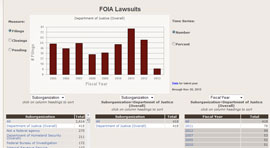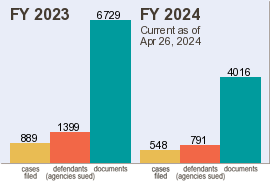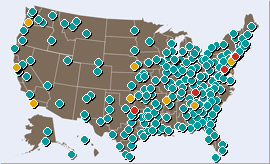We have added 8 documents from 2 FOIA cases filed between September 21, 2014 and September 27, 2014. read more…
We have added 7 decisions of a procedural or substantive nature filed between September 14, 2014 and September 20, 2014. These are associated with 7 FOIA cases pending in federal district court. read more…
We have added 34 documents from 6 FOIA cases filed between September 14, 2014 and September 20, 2014. read more…
A spokesperson for the Administrative Office of the U.S. Courts (AOUSC) told the FOIA Project today that “full electronic access” to more than 800,000 cases removed from PACER will be restored. PACER is the electronic court document management and retrieval system relied on by thousands of researchers, lawyers, journalists and others.
The news was first announced in an article this afternoon by Andrea Peterson, who has been covering the issue for The Washington Post, and later confirmed by FOIA Project and other groups.
However, there is still confusion about what exactly was removed from PACER and what exactly will be restored. The documents were removed without warning in August because, according to the AOUSC, they were in a format that prevented the records from migrating to a new PACER that is being developed. The cases removed were closed cases from four appellate circuits and the bankruptcy court for the Central District of California and comprise a fraction of the 33 million cases in the system.
Although AOUSC officials were able to peg the number of affected cases at around 800,000, they were not able to say exactly how many documents or pages those cases encompassed. You can read more about what was removed and the consequences for researchers, lawyers and journalists in our Sept. 5 report.
In an interview with AOUSC staff today, a spokesperson said that only the dockets from the removed cases will be available electronically. But she also said that all of the documents that were removed would be restored. Asked about the apparent contradiction, she said that it was her understanding that the dockets were the only electronically available information on the cases available before the removal because the cases were old and closed. However, at least some of the cases would have been fairly recent. For example, the U.S. Court Appeals for the Federal District had all of its cases removed prior to March 1, 2012.
The spokesperson said the dockets for the appellate courts would be back online by the end of October, and that the bankruptcy court dockets would be restored after work on the appellate cases is complete.
The FOIA Project will continue to follow this story and share additional information as it becomes available.
We have added 7 decisions of a procedural or substantive nature filed between September 7, 2014 and September 13, 2014. These are associated with 7 FOIA cases pending in federal district court. read more…
We have added 74 documents from 13 FOIA cases filed between September 7, 2014 and September 13, 2014. read more…
We have added 15 decisions of a procedural or substantive nature filed between August 31, 2014 and September 6, 2014. These are associated with 15 FOIA cases pending in federal district court. read more…
We have added 24 documents from 4 FOIA cases filed between August 31, 2014 and September 6, 2014. read more…
Research and advocacy groups are exploring ways to restore access to the more than 800,000 cases that were recently removed from PACER, the electronic search and retrieval system for federal court documents.
It is a task made all the more difficult since the records were taken down without public notice or consultation.
With advanced notice, groups seeking to compile and make available federal court documents could have focused on the records that were targeted for removal, said Brian Carver, an assistant professor at the University of California at Berkeley School of Information and director of the Free Law Project. The Free Law Project and Princeton University have teamed up to create RECAP the Law, a browser extension that captures documents downloaded from PACER (at the standard 10 cents-a-page rate) and then makes them available for free on the Web.
“We could have asked RECAP users to focus on the court cases being removed, although it is not clear that we would have made a dent because of the massive number of documents,” Carver said. “Still, we could have made the effort, or perhaps teamed with a commercial provider like Bloomberg to make sure these documents were still available. I also suspect there were technical solutions that, if the right experts were consulted, would have allowed those documents to remain on PACER. If they are in one database, you should be able to migrate them to another.”
Carver is now part of a group spearheaded by Public.Resource.Org that has written to the chief judges of the five affected courts requesting access to digital copies of the records so that they can be made available.
Other efforts are underway as well. Holly M. Riccio, president of the American Association of Law Libraries, said the AALL government relations staff has been in discussions with the Administrative Office of the U.S. Courts to advocate for restoration of the documents, to learn about additional changes that may be coming to PACER, and to encourage a more consultative approach to any future changes to the system.
The changes took place on either Aug. 10 or 11. The announcement of the change went up at the same time the documents were removed, an AOUSC spokesperson said. Concerns about the missing cases began to surface last week.
AOUSC spokesman Charles Hall said that the documents were removed because upgrades to PACER are incompatible with the record management systems of a handful of courts. He said that only about 800,000 cases out of more 33 million were affected. He added that all the cases removed are closed, and that the majority come from a single court, the California Central Bankruptcy Court.
“In addition to being closed cases, they happen to be cases that few seemed to need access to,” Hall said. “The removed cases accounted for less than 1/10th of 1 percent of total search requests on PACER.”
But as the BBC pointed out, some of the affected cases are of significant historical interest, including Ricci v DeStefano, a high-profile racial discrimination case heard on appeal by Sonia Sotomayor – now a Supreme Court Justice – when she was on the Second Circuit Court of Appeals. All Second Circuit Court of Appeals cases filed prior to 2010 are among those removed by the courts from PACER.
We have added 10 decisions of a procedural or substantive nature filed between August 24, 2014 and August 30, 2014. These are associated with 9 FOIA cases pending in federal district court. read more…

 Recent Tweets
Recent Tweets


